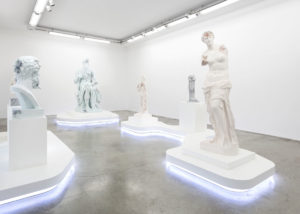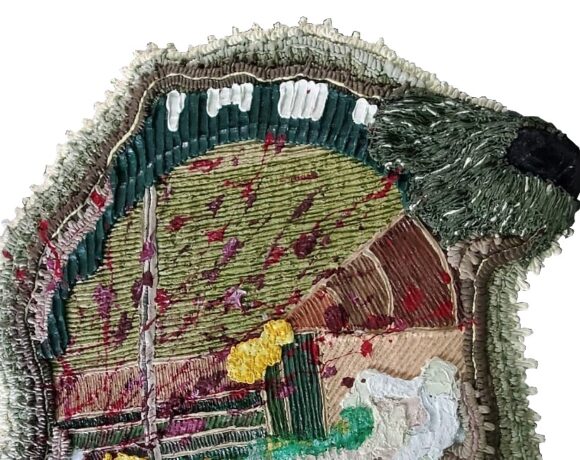To best describe this incredible exhibition and above all the innovative approach of Daniel Arsham, it is necessary to start from him, the artist, and then to begin this article in the most classic way … Born in 1980 in Ohio (USA), Daniel Arsham is a multidisciplinary artist whose artistic language is manifested through performance and different plastic arts such as sculpture and architecture.
The choice of these expressive forms is no coincidence for the artist who obtained a diploma in architecture in the prestigious and extremely selective Cooper Union for the Advancement of Science and Art in Manhattan. This University, founded in 1859, is the only one that guarantees a full scholarship to all those admitted to it with the aim of offering the highest quality of teaching to the most deserving students, no matter what social class they belong to. Shortly after finishing school, Daniel Arsham collaborated as a production designer with the legendary choreographer Merce Cunningham.
His works to date have been exhibited, among others, at the MoMA PS1 in New York, at the Museum of Contemporary Art in Miami, at the HOW de Shangai Museum, at the Biennale of Athens, at the Carré d’Art de Nimes and obviously at the Perrotin Gallery which represent him in Paris.
The exhibition Paris, 3020, which offers only recent works by the artist, has an evocative title since it shows a future date, one exact millennium after the year in which we find ourselves.
It is therefore immediately understandable, even for those unfamiliar with Arsham’s work, that one of the artist’s objectives is to face, as he had done in the past, the theme of temporality. In fact, it is a theme that attracts many, especially given that in the context in which we live we rarely anchor in the present but we think about the past and inevitably, we project ourselves into the future, sometimes even with fear. The peculiarity of Daniel Arsham is that in his works he skillfully superimposes the three faces of temporality (past, present and future); in one sentence one could say that these “future objects of the past disintegrate in the present”. Okay, maybe I skipped a step … let’s go back a moment.
As we have seen, architecture plays a fundamental role in Arsham’s reflection and creation process. During his artistic activity he represented eroded walls, ruined buildings in which nature takes over and stairs that lead nowhere: the artist uses architecture in a paradoxical way forcing the forms to blend in with the space, through simple gestures.
For example, in his Future Relic project, Daniel Arsham created sculptures, made of volcanic stone or limestone, casting objects of our daily life (a camera, a stereo, headphones for music …) and then made two films in which stages these sculptures represented as fossils that are found after a cataclysm that hit the Earth. These objects have a bright but disintegrated appearance, as it happens with the sculptures of Paris, 3020.
However, unlike the previous works, those exhibited in the exhibition at the Perrotin Gallery seem to more reflect the past. Indeed, it is a question of the reinterpretation of ancient sculptures so important that they have now transcended the status of art objects and have become part of the collective memory.
In fact, from the first room one can admire the reinterpretations of two major works of classical antiquity, the Venus of Arlès and a reproduction of the head of Lucilla, daughter of the Roman emperor Marcus Aurelius. I would not spoil you too much but there are also works such as Michelangelo’s Moses and Venus by Milo, surrounded by a series of life-size busts and sculptures, including the busts of Emperor Caracalla and Athena. An association that should make the lovers of ancient art straighten the antennas since it is a matter of paying homage to the flagship themes of this era: royalty and divinity. In addition, the exhibition presents the drawings that Arsham made during the creation process and which recall not only his training as an artist but also the importance of this passage in order to reclaim the works of the past and, ultimately, to proceed to a new creation.
To carry out this ambitious project, Daniel Arsham was able to use the casts of the sculptures present in the collections of the Louvre museums, the Acropolis of Athens, the Kunsthistorisches in Vienna and the basilica of San Pietro in Vincoli in Rome. The artist had the privilege of collaborating with the molding workshop of the Réunion des Musées Nationaux – Grand Palais (RMN), one of the most important cultural bodies in Europe. Active for more than two centuries, this laboratory manufactures high-quality reproductions of the greatest masterpieces and has a collection of casts ranging from those illustrating the art of prehistory to Eastern, Egyptian, Greek and Roman, Etruscan and Gallic-Roman antiquities, as well as Italian, French, Anglo-Saxon and Northern European masterpieces from the Middle Ages to the 20th century. In short, opening the doors of an “atelier” as the French call it, so prestigious to a contemporary artist, means placing in him a great trust and an equally great expectation. An expectation that has not been ignored, given the impressive effect that the sculptures of Daniel Arsham make, which have parts eroded by the artist himself in homage to the techniques of the sculptors of the Renaissance, and from which minerals of different shapes and colors come out, such as from a mysterious cave. The artist seems to suggest that an even more precious content is hidden under the smooth and glazed surface of these statues. It is also interesting to note that the figures show erosions at the level of the head, whether it is a cheek, the forehead, the back of the skull or even a half of it, the head, a symbol of the intellect, is always involved. Also the limbs and the back are often eroded, but never the belly or the chest, which are generally associated with emotions, therefore absolutely present in the sculptures.
The artist’s profound respect for the originals is visible thanks also to the type of material he has chosen to use, a particular mixture of cement and plaster (which is a mineral) developed by the engineer Jean Couturier, the “ciment de gypse” resistant to compression and stable to humidity. This procedure was chosen probably not only because it delays the setting and allows some modifications to be made more easily, but also as a reference to the historical sculptural technique of lost wax casting. Moreover, Daniel Arsham has used natural pigments such as volcanic ash, lapislazuli, selenite and quartz, which are similar to those used by classical sculptors. Finally, the artist “signed” his works by applying crystallization, a process he has used countless times.
Arsham himself stated that his interest in relics arose when more than 10 years ago he took part in an archaeological expedition consecrated to one of the most evocative and mysterious statues in the world, one of the Moai statues on Easter Island. Around the latter archaeologists had found tools abandoned by another team of archaeologists, almost a century earlier. Struck by the dissolution of time between the arrival of the first and second archaeologists, Arsham began to think of archeology as a tool that allows us to synthesize the past and the present.
In this sense, the choice of the classic sculptures proposed in the exhibition at Perrotin Gallery with the same exhibition codes used by the museums (pedestals, soft lights, arrangement of the works in succession), an aspect that contributes to question the role of the latter in the construction of History of Art, it is also a way to emphasize the timelessness of certain symbols. Putting the time limits into play with perspicacity and a touch of irony, Daniel Arsham has been defined with a paradox: an archaeologist of the future. For this reason, we could say that his exhibition allows you to cross the door of the past to enter the future.
Ilaria Greta De Santis
Info:
Daniel Arsham. Paris, 3020
11 January – 21 March 2020
Galleria Perrotin
76 Rue de Turenne, Parigi
 View of the exhibition “3020” at Perrotin Paris Photo: Claire Dorn © Courtesy of the artist and Perrotin
View of the exhibition “3020” at Perrotin Paris Photo: Claire Dorn © Courtesy of the artist and Perrotin
 Daniel Arsham, Blue Calcite Eroded Venus of Milo, 2019 Blue calcite, hydrostone 216 x 60 x 65 cm | 85 1/16 x 23 5/8 x 25 9/16 inch 150.00 kg © Courtesy the artist & Perrotin
Daniel Arsham, Blue Calcite Eroded Venus of Milo, 2019 Blue calcite, hydrostone 216 x 60 x 65 cm | 85 1/16 x 23 5/8 x 25 9/16 inch 150.00 kg © Courtesy the artist & Perrotin
 Daniel Arsham, Blue Calcite Eroded Moses, (detail) 2019. Blue calcite, hydrostone. 260 x 119 x 125 cm | 102 3/8 x 46 7/8 x 49 3/16 in Photo: Claire Dorn © Courtesy the artist & Perrotin
Daniel Arsham, Blue Calcite Eroded Moses, (detail) 2019. Blue calcite, hydrostone. 260 x 119 x 125 cm | 102 3/8 x 46 7/8 x 49 3/16 in Photo: Claire Dorn © Courtesy the artist & Perrotin
 Daniel Arsham, Rose Quartz Eroded Hamadryade, 2019 Pink selenite, quartz, hydrostone 117 x 82 x 80 cm Photo: Tanguy Beurdeley © Courtesy of the artist and Perrotin
Daniel Arsham, Rose Quartz Eroded Hamadryade, 2019 Pink selenite, quartz, hydrostone 117 x 82 x 80 cm Photo: Tanguy Beurdeley © Courtesy of the artist and Perrotin

Paraphrasing Fellini, I will tell you that I am an oyster and my path is a grain of sand that is turning into a pearl. From law degree to art history degree at the Sorbonne in Paris. From the French capital I tell you about art.






NO COMMENT